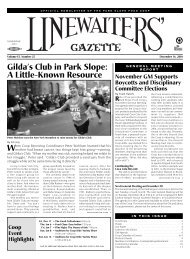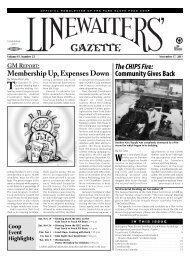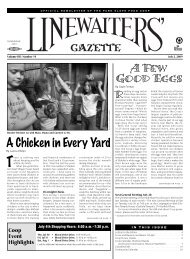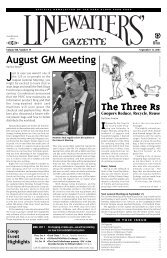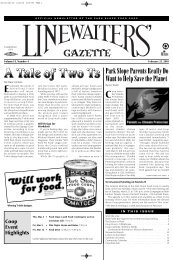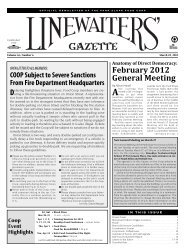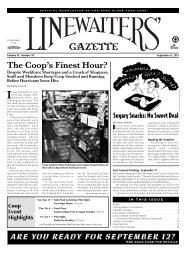Create successful ePaper yourself
Turn your PDF publications into a flip-book with our unique Google optimized e-Paper software.
<strong>Park</strong> <strong>Slope</strong> <strong>Food</strong> <strong>Coop</strong>, Brooklyn, NY August, 31 3<strong>Solar</strong> <strong>Pioneer</strong>CONTINUED FROM PAGE 1For Etta, the equation wasplain common sense: “Whyshould I burn fuel when wehave energy from the sun?”Enter fellow <strong>Coop</strong> membersJeffrey Perlman andAndrew McNamara, environmentalactivists with practicalsolutions.“I wanted to install solarpanels for a long, long time,”Etta recalls, “but I never foundanyone who knew how until Imet them. It figures. Theywere right here at the <strong>Coop</strong>.”Jeff and Andy both studiedapplied physics, and use thatspecialized knowledge in thefield of Building Science.Their Manhattan-based company,Bright Power, helpsindividuals and businessesbecome more energy-efficientto reduce their energycosts. Bright Power offers awide range of services, whichinclude energy auditing toidentify potential improvements;installation of solarand other energy efficientequipment; and co-generation,which develops synergisticinteractions betweenheat, electrical, cooling andother systems to maximizeenergy efficiency. “We look atthe total picture, and figureout the best options,” saysJeff Perlman....home owners like Etta cansave an estimated 50%of their annual waterheating costsEtta’s home was a goodcandidate for roof solar panelsbecause it had 100 squarefeet of unshaded area necessaryto collect sufficient sunlight.A contractor topped herexisting roof with a rubberroof with a reflective aluminumcoating and racks thathold the solar panels. Theseface south at a 30-degreeangle to catch the sunlight.The heat from the sun isabsorbed by a special antifreezefluid, pumped throughthe roof panels. After the heatcapture, the fluid is pipeddown to Etta’s basement,where it flows through a heatexchange coil within a new105 gallon tank that the firminstalled. The heat from thesun passes from the fluid inthe coil into the water in thetank. This now hot water inthe holding tank passes intoEtta’s regular oil-poweredwater heater. Her regularheater won’t need to switchon because the water isalready hot. In the summer,when there’s ample solarpower, this new set-up cansupply approximately 70% ofher water heating needs. Inthe colder months, the systemwill only supply about30% on average. And that’show homeowners like Ettacan save an estimated 50% oftheir annual water heatingcosts.“If we get more peopledoing it, the oil companieswill feel the dent,” Etta predicts.“When I was growing up, itwas the middle of the GreatDepression. People were inwant, and had to make everythingcount. We were taughtnever to waste anything,” Ettasays. “Nowadays, we’re buyingall these appliances—how can we supply power forall of that? This shortageis like the earth saying,‘We cannot supply whatyou are demanding.’ Then toget all the fuel we need, wehave wars and all this killing.When will common sensekick in?” ■CONSIDERING ENERGYEFFICIENCY?There are government incentives for energy optimizationslike Etta’s. Etta can receive $5,000 in tax credits offthe $15,000 she paid for the entire installation, includingthe new roof. Plus she gets an additional reduction in herfees for all new clients she refers.<strong>Solar</strong> panels can also be used to help supply electricity,but an unshaded roof area of at least 300 square feet isneeded. A 300-square-foot system would generate about300 kilowatt hours (kWh) per month. <strong>Solar</strong> panels can beinstalled on either new or existing buildings. The soonersolar is incorporated into a structure’s design, the morecost-effective it will be. Jeff Perlman recommends meetingwith an energy professional early in the planning of a newconstruction or renovation project. Incorporating solarenergy and other energy-efficient systems is most cost-efficientwhen you design and implement them with otherwork on your home.Currently, Jeff and Andy are part of a small group that hashad some initial meetings with General Coordinator JoeHoltz to look into ways to make the <strong>Coop</strong> more energyefficient. Although the <strong>Coop</strong> has been 100% wind-poweredsince June 2005, a possible future energy audit may helpuncover ways to optimize our energy use.ILLUSTRATION BY DEBORAH TINTHeat WaveCONTINUED FROM PAGE 1damage from the heat wavehas not been catastrophic.“You have to keep in mindthat this is a couple weeks ina season, in a long year, in anindustry affected by manyfactors,” the spokesmansaid. He confirmed that thebiggest impact would beon milk products soldnationally.Because theU.S., and especiallyCalifornia,with its $33 billionagricultureindustry,is not just anational but aglobal supplier,Americans will share thefinancial pain caused by thefreakish weather with consumersaround the world. Aswith dairy products, however,prices in the <strong>Coop</strong> should belargely unaffected because ofits policy of buying locally.Also mitigating the effects ofthe heat in the Northeastwere recent rains and thegreater availability of water ingeneral. Another reason,according to General CoordinatorAllen Zimmerman, isthat our major supplier, HepworthFarms, has been willingto keep its prices downfor the <strong>Coop</strong>, a longstandingand important customer.How It StartedThe scorcher began withan unusual combination offactors. Normally, lower offshorewater temperaturescreate breezes of cool marineair that flow inland to bringtemperatures down over landmasses. However, accordingto climatologists, the oceantemperature was unusuallyhigh off thecoast ofCalifornia,preventingthosebreezesf r o mforming. Inaddition,the WestCoast hadto contendwith a flowof warm,sticky airfrom theGulfs ofMexico andCalifornia. Thedense moisture from this airpenetrated into the groundand also worked to preventnighttime cooling off. Anexample of global warming?Very possibly, as anyone whohas seen Al Gore’s An InconvenientTruth could plausiblyargue. The film shows graphicallyhow the earth’s warmingBecause the U.S., andespecially California, with its$33 billion agricultureindustry, is not just a nationalbut a global supplier, Americanswill share the financialpain caused by the freakishweather with consumersaround the world.is causing scenarios like thisone, driving temperaturesinto abnormal ranges andbringing heavy, moistureladenair over some landmasses, while sucking themoisture out of others. Ten ofthe hottest years ever recordedoccurred during the last 14years, the film grimly reports,with 2005 the hottest ever.Ten of the hottest yearsever recorded occurredduring the last 14 years,the film grimly reports,with 2005 the hottest ever.Human DeathsAttributed to HeatMany human beings alsodied. An average of 900 peopleper year have been killedin the U.S. because of heatbetween 1999 and 2003.George Luber, an epidemiologistwho studies heat wavedeaths for the U.S. Centers forDisease Control and Prevention,said that this year’s heatwave should break thatrecord. One hundred thirtyeightpeople died in Californiaalone on account of the heatthis summer. In New York,where it was less intense, thenumber is lower, but final talliesare still unclear, largelybecause of anomalies in theway victims are counted. Thechief New York medical examinerattributed 31 deaths tothe blistering weather ofAugust 1 to 4, but as a NewYork Times article pointed out,the city does not recognizethe category “heat-relateddeath.” Instead, said Dr.Charles S. Hirsch, the chiefmedical examiner, that officereports deaths only fromheatstroke, defined in part ashaving a body temperature ofat least 105 degrees. Yet evenHirsch acknowledged that“not every heat-related deathis manifested by heatstroke.”As a result, many more deathswere probably attributable tothe elevated temperatures.Looking AheadBuying locally and creatingloyalty among its suppliersmay not always protectthe <strong>Coop</strong> from the vagaries ofthe weather, or from increasingtemperatures due to theAdultClothingExchangewarming of the planet, but—at least this time—thesepractices did take some ofthe heat. Over the longerterm, it’s apparent that morefar-reaching, global solutionsmust soon be found to thethreat this phenomenonposes to living things. ■Have you noticed that <strong>Coop</strong> members aregreat dressers!The season is changing, and this is your opportunityto trade gently used and beautiful clothes thatyou no longer wear.A clothing exchange is a communityevent that is ecologically responsibleand fun. Why support the consumermarket and buy, when you canwear clothes that have already been well loved.Bring items that you think others might enjoy–and a snackto share.Saturday, September 16FREENon-members welcome10:00 a.m. – 2:00 p.m.in the meeting roomTo bring Clothes…• Do not leave clothing in the <strong>Coop</strong> before the hours of theexchange.• Bring up to 15 items only• Bring gently used, clean clothing that you are proud to beable to exchange with it's new owner.(Unchosen clothing will be donated to a local shelter.)



